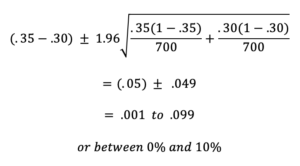A Two Proportion Z-Interval (or Z-Test) allows you to calculate the true difference in proportions of two independent groups to a given confidence interval.
There are a few familiar conditions that need to be met for the Two Proportion Z-Interval to be valid.
- First, the groups must be independent. Subjects can be in one group or the other, but not both – like teens and adults.
- Second, the data must be selected randomly and independently from a homogenous population. A survey is a common example.
- Lastly, the population should be at least 10 times bigger than the sample size. If the population is teenagers for example, there should be at least 10 times as many total teenagers as the number of teenagers being surveyed.
Suppose that in a survey of 700 women and 700 men, 35% of women and 30% of men indicated that they support a particular presidential candidate. Let’s say we wanted to find the true difference in proportions of these two groups to a 95% confidence interval.
At first glance the survey indicates that women support the candidate more than men by about 5%. However, for this statistical inference to be valid we need to construct a range of values to a given confidence interval.
To do this, we use the formula for Two Proportion Z-Interval:

where ![]() is the proportion of group 1 (35% or .35)
is the proportion of group 1 (35% or .35)
![]() is the proportion of group 2 (30% or .30)
is the proportion of group 2 (30% or .30)
![]() is the sample size of group 1 (700)
is the sample size of group 1 (700)
![]() is the sample size of group 2 (700)
is the sample size of group 2 (700)
and ![]() is the z-score for a 95% confidence interval (1.96 from Z-Table)
is the z-score for a 95% confidence interval (1.96 from Z-Table)
Plugging in values we find the true difference in proportions to be

Based on the results of the survey, we are 95% confident that the difference in proportions of women and men that support the presidential candidate is between about 0% and 10%.